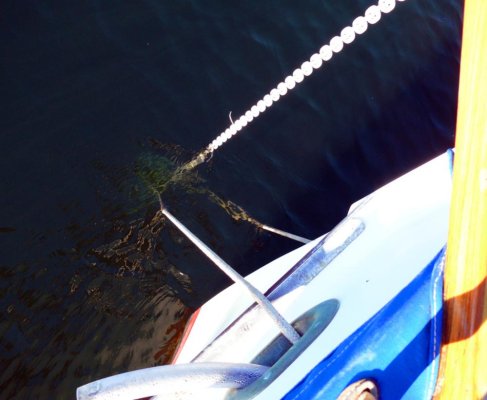jeffnick
Guru
While we're sitting at our desk in front of the computer it's easy to not consider how things can really be out there.
It's blowing 40 in a crowded anchorage. The seas are only 2-3 but the wind is blowing them over the bow. The rain stings your face... You can hardly keep your eyes open. There's a massive boat dragging sideways down on you. If you loose your grip on the bottom, you might end up on the rocks. What do you do?
Power towards the drifting hulk, hoping your motor can dislodge your well set heavy anchor before the hulk makes contact?
Go below to fetch a rusty hacksay and low battery flashlight and try to hack your all chain rode loose under load and blinding rain?
Stand on your head in the dark pounding rain and try to untie your nylon rode's bitter end from something in the chain locker?
I'm just sharing my experiences. They may be of no value to you, but others may appreciate the perspective.
My MO to date:
A Rocna Fisherman for retrieving a conservatively sized fouled lunch hook.
An 'local' anchor about twice the recommended size for overnight or unattended anchoring. Neither scenario uses any chain.
My 3 strand nylon rode is sized at the recommended diameter for the first 150 feet. That bitter end is spliced onto 250' of double that diameter, following that is poly that I have tested to float in 50' of water.
My 'windlass' is a manual sailboat sheet winch. On my boat I can haul in the rode with one hand on the shifter...bumping her as I go. I get a kick out of crewing for my buddy with his electric winch...someone has to be forward to clear it when it jams.
It's blowing 40 in a crowded anchorage. The seas are only 2-3 but the wind is blowing them over the bow. The rain stings your face... You can hardly keep your eyes open. There's a massive boat dragging sideways down on you. If you loose your grip on the bottom, you might end up on the rocks. What do you do?
Power towards the drifting hulk, hoping your motor can dislodge your well set heavy anchor before the hulk makes contact?
Go below to fetch a rusty hacksay and low battery flashlight and try to hack your all chain rode loose under load and blinding rain?
Stand on your head in the dark pounding rain and try to untie your nylon rode's bitter end from something in the chain locker?
I'm just sharing my experiences. They may be of no value to you, but others may appreciate the perspective.
My MO to date:
A Rocna Fisherman for retrieving a conservatively sized fouled lunch hook.
An 'local' anchor about twice the recommended size for overnight or unattended anchoring. Neither scenario uses any chain.
My 3 strand nylon rode is sized at the recommended diameter for the first 150 feet. That bitter end is spliced onto 250' of double that diameter, following that is poly that I have tested to float in 50' of water.
My 'windlass' is a manual sailboat sheet winch. On my boat I can haul in the rode with one hand on the shifter...bumping her as I go. I get a kick out of crewing for my buddy with his electric winch...someone has to be forward to clear it when it jams.

